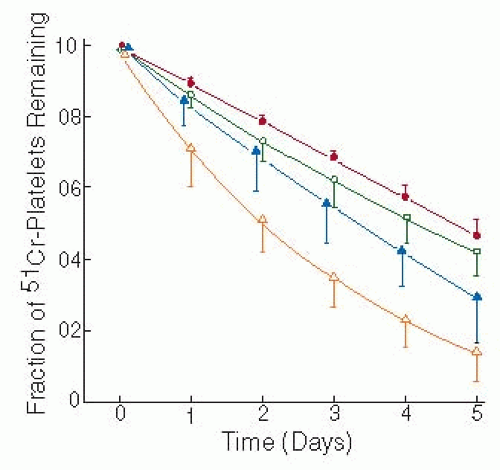The normal range for platelet counts in healthy individuals has been reported as 150,000 to 350,000/µL
4 and is essentially the same regardless of the type of automated hematology analyzer used to measure the platelet count.
5 As determined from an analysis of the cross-sectional Third National Health and Nutrition Examination Survey of the United States population from 1988 to 1994 (NHANES III), mean platelet counts of 26,327 individuals were higher in women than men, independent of the presence of iron deficiency, declined with age, especially after age 60, and were greater in non-Hispanic blacks as compared to non-Hispanic whites and Mexican Americans.
6 Similar differences had been identified in a large cohort of men and women in Israel,
7 in a population study of whites, Africans, and Afro-Caribbeans in London,
8 and in 3,311 HIV-negative Ugandans.
9 In a study of platelet counts in 12,517 individuals in 10 relatively isolated villages in the Ogliastra area of Sardinia, the prevalence of thrombocytopenia (defined as a platelet count <150,000/µL) in different villages ranged from 1.5% to 6.8%, and there was a progressive decrease in platelet number with aging.
10 It is noteworthy that the prevalence of thrombocytosis also differed between villages and was inversely related to the prevalence of thrombocytopenia. Thus, the normal range for platelet counts varied from village to village, implying that the normal range for platelet counts can be influenced by genetic factors and is consistent with the finding of significant heterogeneity in the distribution of single-nucleotide polymorphisms among the villages. Genetic polymorphisms that affect the platelet count in a negative and positive fashion have been identified in the genes for interleukin-6 and the thrombopoietin receptor c-mpl.
11,12,13 Although these differences in mean platelet count affect populations rather than individuals, and are relatively mild so that they are unrelated to the efficiency of hemostasis, it is important to be cognizant of the fact that there are differences in the normal range of platelet counts when analyzing the effect of medications, therapy, and devices that can affect the platelet count such as immunization.
14Although the clinical significance of severe thrombocytopenia is usually readily apparent, the nature and significance of borderline thrombocytopenia, that is, platelet counts between 100,000 and 150,000/µL, can be a vexing problem. With the advent of automated cell counting, asymptomatic individuals with incidentally discovered borderline thrombocytopenia are being identified with reasonable frequency. While some of these individual, by necessity, represent outliers of the normal distribution of platelet counts, the thrombocytopenia of others could represent an early manifestation of an unrecognized disease. In the absence of positive findings, many of these individuals are given a diagnosis of idiopathic autoimmune thrombocytopenia (ITP). To address the paucity of information about the fate of individuals with borderline thrombocytopenia, Stasi et al.
15 prospectively studied 217 apparently healthy individuals incidentally discovered to have borderline thrombocytopenia as defined above. When followed for 6 months, two of the subjects were found to have myelodysplasia and a third systemic lupus erythematosus (SLE). The platelet counts of 23 others increased into the normal range for at least 3 months, whereas the platelet counts of 11 declined to <100,000/µL, and they were classified as having ITP. One hundred ninety-one subjects who continued to manifest borderline thrombocytopenia at 6 months were then followed for a median duration of 64 months. Thirteen subjects achieved stable platelet counts >150,000/µL and 109 continued to have stable borderline thrombocytopenia. Platelet counts of 12 subjects declined to <100,000/µL, and these subjects met the study’s criteria for ITP. Of the 11 subjects initially thought to have ITP, five subsequently developed autoimmune disorders. Overall, the probability of developing ITP in these subjects at 10 years was calculated to be 6.9%, and the probability of developing another autoimmune disorder at 10 years was 12.0%. However, the majority of subjects continued to manifest borderline thrombocytopenia without developing another disorder. Thus, it is likely that they simply represent the lower end of the normal platelet count distribution. Moreover, based primarily on the results of this study, as well as on the observations discussed above that platelet counts <150,000/µL are frequently found in apparently healthy individuals in some non-Western populations, the International Working Group of the Vicenza Consensus Conference set the threshold for the diagnosis of ITP at a platelet count of <100,000/µL.
16 Nonetheless, we have encountered a number of patients with borderline thrombocytopenia who have either intermittently or progressively developed symptomatic thrombocytopenia consistent with a diagnosis of ITP. While it may be inappropriate to label all patients with borderline thrombocytopenia with a diagnosis of ITP when their thrombocytopenia is first discovered, these patients should be monitored to determine if ITP does eventually develop.










